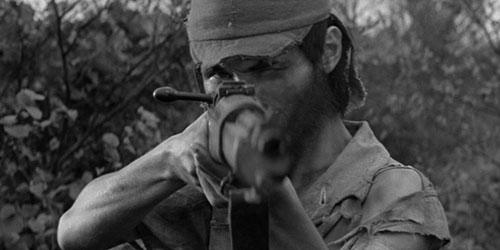Fires on the Plain (1963), directed by Kon Ichikawa, is a staggering work of art and stands as a pillar of antiwar cinema. While other war films tell glorified stories of bravery and sacrifice, this is a film about desperation and survival resulting from war. Its backdrop is a surreal landscape of violence, brutality and carnage. We follow the film’s protagonist, Japanese Army Private Tamura (Eiji Funakoshi), as he wanders the scarred countryside of a nameless Philippine island with no purpose or objective other than to survive another day. He acts as our eyes, a witness to the horrors and strange beauty around him. Similar to Terrence Malick’s The Thin Red Line, this film takes the audience on a meandering descent into a man-made hell.
Suffering from tuberculosis, Private Tamura is told by military medical staff that he can no longer stay in the field hospital. As he is too unwell to fight, they suggest he do the honorable thing and kill himself. He chooses a chance at life over the certainty of death and sets off across the island in search of some kind of salvation. Meanwhile the Japanese army is in retreat and the Allies are closing in on all sides. He is a nomad in a war torn land where there is no heroism because there is no solidarity, no patriotism, no pride, and nothing to fight for or against. There is only death and destruction. Everything around Tamura wants to kill him: the Japanese army may execute him as a deserter, the Filipinos are looking for revenge and the Americans, victory plainly in sight, are in mop-up mode. One of the most unique aspects of this film is its lack of historical reference. Rather than a movie about the War in the Pacific, Fires on the Plain is about the concept of “War” and the universal themes that apply to all military conflicts. The violence depicted on screen is futile and animalistic. In a desperate time of war, all human desire has been distilled down to pure self-preservation.

“Man vs Nature” and “Man vs Himself” are big themes in this film. As a result of the ravages of war, the protagonist is in constant battle with his own body (sickness, starvation, dehydration) and the island itself. He is often dwarfed by his surroundings, which are presented in gorgeous black and white by cinematographer, Setsuo Kobayashi. The scenes vary from dense jungles, to rough windswept mountains, to raging rivers and smoldering fields. Tamura’s aimless and frantic attempts to survive seem utterly futile compared to the magnitude of destruction. In this way he appears less than human. He is more like an animated scarecrow, a thin bundle of rags crawling through the picture. We are not given access to his thoughts, there are no voiceovers, which also contributes to his dehumanization.
What makes Fires on the Plain one of the best antiwar films ever made all boils down to the direction of Kon Ichikawa. The antiwar genre is not new to him. In 1956 he directed The Burmese Harp, another staggering work of antiwar cinema that focuses on the turmoil surrounding the end of World War II. Fires on the Plain is based on a novel by Shohei O-oka which retells a true story. But rather than attempt a straight forward representation of the novel, Ichikawa infuses elements of the surreal so that we may more viscerally experience the protagonist’s personal hell. Tamura is often in a daze due to his fever and/or lack of food and water. The jungles and fields are littered with corpses, fire, and destruction of all kinds. At times it feels as though he is traversing one of the levels of Dante’s Inferno. Tamura does little to affect events or actions that unfold around him. When he does act, it’s for nothing (he kills a woman for no other reason than she screamed when he approached her.) During much of the movie he seems to be invisible to other characters, as if he is a member of the walking dead.
Fires on the Plain is exceptional in its depiction of the awesome vacuum that war leaves behind. Though the War in the Pacific is coming to an end, the film portrays the suffering that continues to the bitter end…and after. Similar to other great antiwar films such as Paths of Glory (directed by Stanley Kubrick) and The Bridge (directed by Bernhard Wicki), Fires on the Plain is a critique of human nature. In these movies we see men committing the basest of actions: killing, robbing, sacrificing others to get ahead, and even resorting to cannibalism, all in a desperate desire to survive. Fires on the Plain does not hit you over the head with the horrors of war but lays them out before you, making you wonder if you would be capable of the same actions under similar circumstances. It also makes you wonder if we are any better than our animal counterparts. If this film is any judge, we are not. Kon Ichikawa exposes our lust for violence, our desperate clawing for territory and limitless capacity for self-preservation. In some ways this film covers many of the same themes as Lord of the Flies. When civilization and order are removed, human beings naturally devolve until there is very little left of what made us human in the first place.

